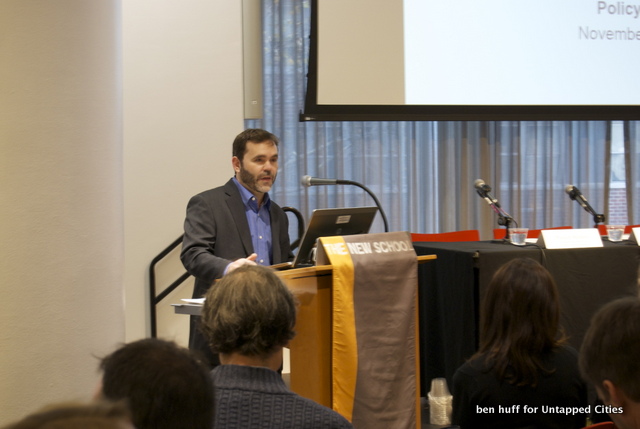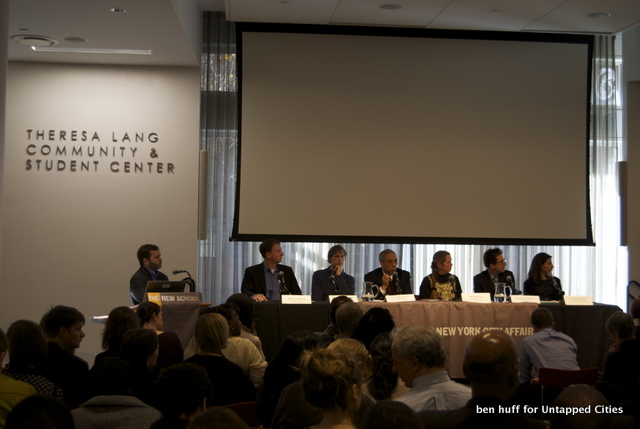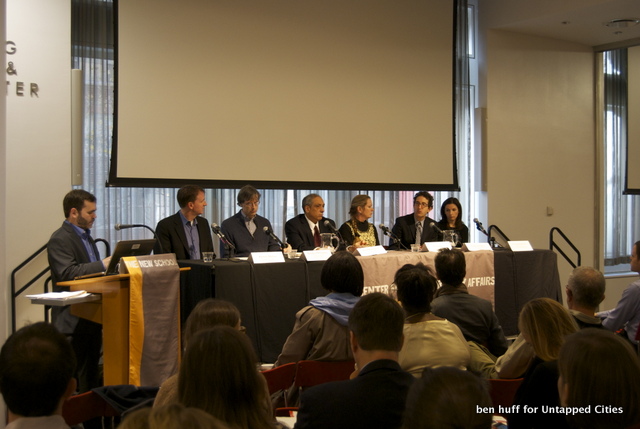
He ran on a “Tale of Two Cities” platform, and when he enters office on January 1st, Bill De Blasio will have to put a lot of forces in motion to tackle the issue of homelessness in New York City. To continue to shed light on this subject The New School’s Center for New York City Affairs recently hosted a public forum featuring a mix of academics and scholars, all of whom work on this issue daily.
The forum began with remarks by Andrew White and Paul Markee, who represent The Center for New York City Affairs and the Coalition for the Homeless, respectively. Together they helped contextualize where homelessness is today, what the trends are showing and initial solutions they see. 52,351 New Yorkers walk through the doors of shelter homes each day, of which 12,464 are families and 22,136 are children. The number of homeless people in the city has increased by 69 percent in the last twelve years, according to the Coalition for the Homeless.
Markee believes that this started in 2005 when the administration stopped dedicating money for permanent housing, usually in the form of Section 8 housing vouchers, and shifted the funds elsewhere. Section 8 subsidies came in the form of rent money. Markee contends that it is cheaper to give a family $1,000 a month as a rent subsidy, rather than to pay for the full cost of hosting them in a shelter. This move also coincided with when the city and the state began distancing themselves from each other on the issue of homelessness One solution Markee suggests is to get New York City and Albany together again to match up money and resources.

The panel itself kicked off with Louis Rodriguez of St. John’s Place Family Center, a program that oversees services to the homeless to get them on a path out. Rodriquez explained that through the ’90s with plentiful subsidies they were able to put 150 families into permanent housing per year. St. John’s was successful at helping homeless families because they were flexible enough to deal with a range of issues, providing day care for families with working parents, and education for those seeking GEDs. They still follow this model but with less housing voucher subsidies, they help fewer families each year.
Next was Josh Goldfein, senior staff attorney for the Legal Aid Society and overall homeless advocate who focused a lot on the relationship between those who run shelters and those who use them. Shelters without the support and care of a staff can exasperate the issue. Having shelters with unhelpful staff, or staff who turn families away, can cause a lot of stress in the environment and can make it even harder for to procure jobs or adapt to society. Goldfein emphasized the ripple effects that happen when the path through homeless shelters are not ideal, and the costs then get shifted to the education and justice systems.
Next Elizabeth Brown, an analyst for the New York City Independent Budget Office, spoke about the costs the City spends on homeless shelters. Currently the City spends a billion dollars a year–a lot for the city to spend on shelters–but clearly just spending money will not fix the issue. An extremely small amount, about $35 million has been spent on prevention, and there we clearly could have growth, she says.
Finally Ellen Baxter of Broadway Housing Communities spoke about the opportunities and challenges that non-profits face when financing and building affordable housing projects. The advantage of a non-profit builder is that they can provide support and a community for families to limit the chances they return to homelessness. A real estate developer tends to build exactly the amount of units that is needed to satisfy zoning requirements and subsidies, and a lot of these are not necessarily dedicated to those that are within the shelter system.
Non-profit developers often go beyond these requirements. Baxter’s company’s most recent project, the Sugar Hill development in Harlem, also includes an early childhood education center. While the center is not funded yet, the developers were willing to dedicate the space. She hopes that this development can be seen as a model for how to combine multiple resources to provide multiple services in a decentralized system.
It was here where most of the panelists were able to agree upon. The issue of homelessness is complex and certainly challenging, but the best approach to start is to decentralize the current system. As a city made up of five boroughs and hundreds of neighborhoods, the city is designed so that it could take this approach. The question that wasn’t answered but was pondered is, what will the next mayor do? For now we can only wait and see.






